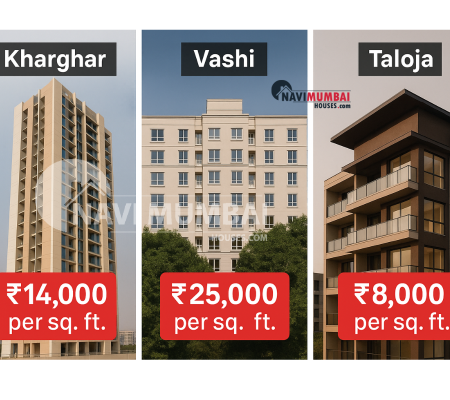
1. Awareness: Why You Should Care About 2025 Rates
If you are planning to buy or invest in Navi Mumbai right now, you’re in a sweet spot. The region is enjoying infrastructure rollout (metro, airport, roads), and realty growth is substantial. In fact:
-
Navi Mumbai saw a 17.4% increase in home prices in Q1 2025 over the previous year.
-
Average residential flat prices across the city now span roughly ₹7,500 to ₹15,000 per sq ft, depending on locality, amenities, and connectivity.
-
Areas like Kharghar, Ulwe, Panvel, and even Dronagiri are being closely watched for their growth potential.
Knowing current rates—and forecasting where they will go—can help you make a safer, better-timed property decision.
2. Problem: Why Many Buyers Overpay or Pick the Wrong Node
Here are common missteps:
-
Ignoring micro-location differences
Many buyers see “Navi Mumbai” and assume all rate ranges apply—only to realize their selected node is on the lower end, or overpriced for what you get.
-
Failing to factor in infrastructure
A flat close to a metro station or airport node may command a premium, but bring better appreciation. People sometimes ignore that.
-
Relying purely on old data
Rates shift rapidly in emerging markets. 2022 or 2023 figures may be obsolete.
-
Not comparing apples to apples
A “flat in Vashi with sea view + amenities” is very different from a basic flat in Taloja.
To avoid mistakes, you need fresh, area-wise, realistic data, plus context about what’s driving them.
3. Positioning: Navi Mumbai 2025 Rates & Trends (Node-Wise)
Let me break down typical rates by major nodes, what’s happening now, and which ones are undervalued or overheated.
| Locality / Node | Average Rate (₹/sq ft) | Range / Notes | Trends & Insights |
|---|---|---|---|
| Kharghar | ~ ₹10,000 – ₹13,500 | In many projects, especially mid to premium ones. | Strong demand because of the node’s maturity, amenities, and good connectivity. |
| Ulwe | ~ ₹9,000 – ₹12,000 | Getting significant attention due to the airport node status. | One of the more dynamic nodes. Prices are likely to rise faster if airport and connectivity projects deliver. |
| Panvel | ~ ₹7,500 – ₹10,500 | Balanced mix of affordability + growth potential. | A good choice for those wanting upside without paying top premium now. |
| Taloja | ~ ₹6,500 – ₹8,500 | More affordable, growing nodes. | High-risk/high-reward. If metro & road access improve, the potential is good. |
| Nerul / Vashi / Belapur | ~ ₹11,000 – ₹18,000+ | In already established, well-connected nodes. | Premium nodes: slower growth but more stability and lower risk. |
| Dronagiri | ~ ₹5,500 – ₹7,500+ | Emerging, more remote node now, but very low base. | Good long-term bet if supporting infrastructure comes. |
| Kamothe | ~ ₹8,800+ | Mixed node, in between mature and remote. | Has room to grow, especially with better connectivity. |
-
Kharghar: ~ ₹10,438 / sq ft (average)
-
Ulwe: ~ ₹8,408 / sq ft average
-
Panvel: ~ ₹8,312 / sq ft average
-
Taloja: ~ ₹6,165 / sq ft average
These averages include a wide range (low to high) depending on project amenities, size, view, etc.
4. What’s Driving These Differences & What to Watch
Several key factors explain why rates vary so much, and which ones will cause further movement:
-
Proximity to infrastructure
Metro stations, major roads, airport, sea link (MTHL) — nodes near these command a premium.
-
Node maturity & amenities
Nodes like Nerul, Vashi already have schools, malls, and healthcare; newer nodes may lack these initially.
-
Supply & developer activity
Many new launches are happening in Ulwe, Panvel, etc. That brings competition, but also rate moderation initially.
-
Speculation & expectations
Some buyers pay ahead of infrastructure based on expectations. If projects do not deliver, risk is higher.
-
Land/circle / ready reckoner rates
These set the floor. In many cases, developers price well above the official circles in growing nodes.
-
Rate growth momentum
As noted, Navi Mumbai’s growth in 2025 is strong, with some nodes showing double-digit growth.
Recent highland deals also speak to investor sentiment: For example, 4 CIDCO tender plots in Nerul sold at ₹7.65 lakh per sq metre recently, signaling strong land value in established nodes.
5. How to Use This Data as a Buyer / Investor
Here’s how you can convert rate data into decision power:
-
Compare nodes based on your budget & risk appetite
If you want less risk, go for nodes like Kharghar, Nerul, and Vashi. If you can wait and want higher upside, Ulwe, Taloja, and Panvel make sense now.
-
Calculate your “value point”
Suppose, based on your budget, you can afford ₹10,000 / sq ft. That might get you a good flat in Ulwe or Kharghar, but only a basic shell in Vashi or Nerul.
-
Watch infrastructure timelines
A node’s value depends heavily on when the metro/airport/roads get completed, not just announced.
-
Don’t assume uniform rates within a node
A flat facing a garden/lake/lake view / premium floor can cost 20–30% more than a typical one in the same building.
-
Estimate appreciation, not just cost
Buy where you see future growth, not just the lowest price. A node going from ₹6,500 to ₹10,000 in 5 years is a better bet than one stuck at ₹15,000.
Takeaways
In 2025, Navi Mumbai’s real estate market is vibrant and full of opportunity—but only if you understand rate variation, node risk, and infrastructure influence.
Average residential rates range from ₹6,500 to ₹15,000 per sq ft, but prime nodes can exceed that. Nodes like Kharghar, Ulwe, Panvel, and Taloja stand out in terms of potential.
Use this data wisely: look for nodes where infrastructure will land, compare project specs, and align with your risk / return expectation. That’s how you turn square feet into real value.
Visit Us: navimumbaihouses.com or Call on @ 8433959100
The post Navi Mumbai Property Rates 2025 — Where to Buy & Why appeared first on .

